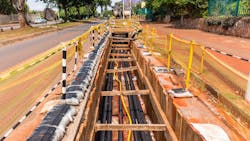With longer, more active fire seasons, close attention is being paid to the ignition sources of wildfires, whether it be a lightning strike, spark from a campfire or an electrical malfunction. According to data from the U.S. Forest Service, more than 32,000 wildfires were ignited by T&D lines in the U.S. from 1992 to 2020. Furthermore, wildfires sparked by electrical wires can spread faster than other types of ignition sources since T&D lines are elevated in remote and windy areas.
And when they are not the source of ignition, T&D lines can be adversely impacted by wildfires, which negatively affects the supply of power to homes and critical institutions, such as hospitals, schools, shelters and first-responder communications.
All this begs attention for fire prevention efforts to minimize the instances of utility-related ignitions and the consequential damage. From overhead to underground transmission infrastructure, the time is now to adopt measures that will protect the electrical grid.
Covered Lines
Today, most overhead T&D lines are bare. In the past, they were not insulated because air is a good insulator. However, due to changing weather patterns, overgrown vegetation, wildlife and other human factors, power lines are more at risk now than ever before. These factors combined with aging infrastructure can lead to a spark that ignites a fire and evolves into a wildfire.
Covering wires and cables with proper insulation protects them and provides other benefits. For example, insulation can improve performance and even mitigate the impact of faulty or sparking lines.
In today’s world of increased wildfire risk, the traditional practice of bare wires and cables will no longer suffice. Transitioning to covered lines is a good starting point when it comes to fire prevention. There are many polymer solutions, such as cross-linked polyethylene (XLPE), that can protect overhead lines. Dow has a full range of products to cover wire and cables, from the conductor shield to the inner and outer layers.
As the industry progresses toward implementing covered wires, cables and beyond, the materials science field continues to innovate safer and more reliable solutions. For example, the use of halogen-free flame-retardant (HFFR) materials in covered wires and cables offers the potential to enhance fire safety and reduce the negative impacts of halogenated materials on the environment and human life. While flame retardant materials are not a requirement yet in covered wires and cables, the added benefits of using this material can help to propel the future of wire and cable solutions.
Dow is addressing the electric power industry's needs with UNIGARD RE Flame-Retardant Compounds to enhance the safety and protection of covering on wires and cables by helping to minimize the risk of fires. With performance that exceeds industry standards, these materials demonstrate low levels of smoke, corrosivity and toxicity. By prioritizing flame-retardant protection against electrical fires involving T&D infrastructure, environmental and personal safety can be enhanced.
Undergrounding Wires
Proper insulation is not only beneficial for aboveground wires and cables but also opens up possibilities to place them underground. As the industry looks for additional alternatives to better protect the electrical grid, some wires and cables are being moved underground. Covered wires and cables also improve the performance of underground transmission infrastructure.
When cable lines are installed underground with proper insulation materials, they are more durable and hold up in the face of increasingly severe threats like wildfires. In fact, undergrounding yields the lowest maintenance cost, vegetation management cost and outage minutes, along with higher resiliency, reliability and customer satisfaction.
While undergrounding is becoming more commonplace, because of its higher initial installation cost, the industry is still assessing the most strategic way to adopt it more widely. The prevention benefits of reducing utility-related ignition sources are compelling. Advancements in materials science are enabling lower total cost of ownership, making undergrounding a more viable option.
For example, underground cables made with ENDURANCE Compounds for Cable Systems from Dow have demonstrated the ability to help produce more efficient, longer-lasting cables with decades of excellent, reliable service.
Understanding the importance of undergrounding in protecting the electrical grid, the Power Delivery Intelligence Initiative (PDi2) recently released a white paper to help utilities assess and choose defined line segments where strategic undergrounding is the lowest life-cycle cost and will achieve resiliency and reliability targets. However, it will take industry-wide collaboration to gain further adoption, which is why Dow participates in this forum by sharing its experience in materials science.
Start With The Right Materials
Prevention, preparedness and response are all of equal measure in addressing wildfire risk. With respect to prevention, even with burn bans in place across the U.S., preventing wildfires remains difficult — especially with aging and bare wire and cable infrastructure. A key element of wildfire mitigation begins with the materials used to build T&D infrastructure.
To ensure safety in T&D, the industry must collaborate across the value chain to continue innovating and adopting options that keep communities protected from wildfires. While undergrounding is a forward-looking innovation, it will take time and resources for wider adoption.
In the near term, insulating overhead wires and cables can help to reduce risk — especially since advances in materials science can make it more cost efficient. Using safe, reliable and durable materials that are already available can help utilities to build the infrastructure of today and tomorrow.
Paul Brigandi is a senior technical services and development scientist of wire and cable at Dow Packaging and Specialty Plastics.
About the Author
Paul Brigandi
Paul Brigandi is a senior technical services and development scientist of wire and cable at Dow Packaging and Specialty Plastics.
